Investigating the Role of Organic Aerosol Schemes in the Simulation of Atmospheric Particulate Matter in a Large Mediterranean Urban Agglomeration
Abstract
1. Introduction
2. Materials and Methods
2.1. Modeling System Set-Up
2.2. Observational Data and CAMx Evaluation Methodology
3. Results
3.1. Comparison by OA Scheme of CAMx Performance in the Simulation of PM Concentrations
3.2. Comparison by OA Scheme of CAMx Performance in the Simulation of OA Concentrations
4. Discussion
4.1. POA and SOA Concentrations Apportionment by OA Scheme
4.2. Insights on SOA Levels Underestimation by CAMx
5. Conclusions
Supplementary Materials
Author Contributions
Funding
Institutional Review Board Statement
Informed Consent Statement
Data Availability Statement
Acknowledgments
Conflicts of Interest
References
- European Environmental Agency. Health Impacts of Air Pollution in Europe. European Environmental Agency Web Report. 2022. Available online: https://www.eea.europa.eu/publications/air-quality-in-europe-2022/health-impacts-of-air-pollution (accessed on 14 December 2024).
- Kanakidou, M.; Seinfeld, J.H.; Pandis, S.N.; Barnes, I.; Dentener, F.J.; Facchini, M.C.; Van Dingenen, R.; Ervens, B.; Nenes, A.; Nielsen, C.J.; et al. Organic Aerosol and Global Climate Modelling: A Review. Atmos. Chem. Phys. 2005, 5, 1053–1123. [Google Scholar] [CrossRef]
- Jiang, J.; Aksoyoglu, S.; El-Haddad, I.; Ciarelli, G.; Denier Van Der Gon, H.A.C.; Canonaco, F.; Gilardoni, S.; Paglione, M.; Minguillón, M.C.; Favez, O.; et al. Sources of Organic Aerosols in Europe: A Modeling Study Using CAMx with Modified Volatility Basis Set Scheme. Atmos. Chem. Phys. 2019, 19, 15247–15270. [Google Scholar] [CrossRef]
- Tsigaridis, K.; Daskalakis, N.; Kanakidou, M.; Adams, P.J.; Artaxo, P.; Bahadur, R.; Balkanski, Y.; Bauer, S.E.; Bellouin, N.; Benedetti, A.; et al. The AeroCom Evaluation and Intercomparison of Organic Aerosol in Global Models. Atmos. Chem. Phys. 2014, 14, 10845–10895. [Google Scholar] [CrossRef]
- Tsiaousidis, D.T.; Liora, N.; Kontos, S.; Poupkou, A.; Akritidis, D.; Melas, D. Evaluation of PM Chemical Composition in Thessaloniki, Greece Based on Air Quality Simulations. Sustainability 2023, 15, 10034. [Google Scholar] [CrossRef]
- Strader, R.; Lurmann, F.; Pandis, S.N. Evaluation of Secondary Organic Aerosol Formation in Winter. Atmos. Environ. 1999, 33, 4849–4863. [Google Scholar] [CrossRef]
- Robinson, A.L.; Donahue, N.M.; Shrivastava, M.K.; Weitkamp, E.A.; Sage, A.M.; Grieshop, A.P.; Lane, T.E.; Pierce, J.R.; Pandis, S.N. Rethinking Organic Aerosols: Semivolatile Emissions and Photochemical Aging. Science 2007, 315, 1259–1262. [Google Scholar] [CrossRef]
- Koo, B.; Knipping, E.; Yarwood, G. 1.5-Dimensional Volatility Basis Set Approach for Modeling Organic Aerosol in CAMx and CMAQ. Atmos. Environ. 2014, 95, 158–164. [Google Scholar] [CrossRef]
- Donahue, N.M.; Epstein, S.A.; Pandis, S.N.; Robinson, A.L. A Two-Dimensional Volatility Basis Set: 1. Organic-Aerosol Mixing Thermodynamics. Atmos. Chem. Phys. 2011, 11, 3303–3318. [Google Scholar] [CrossRef]
- Donahue, N.M.; Kroll, J.H.; Pandis, S.N.; Robinson, A.L. A Two-Dimensional Volatility Basis Set—Part 2: Diagnostics of Organic-Aerosol Evolution. Atmos. Chem. Phys. 2012, 12, 615–634. [Google Scholar] [CrossRef]
- Fountoukis, C.; Megaritis, A.G.; Skyllakou, K.; Charalampidis, P.E.; Pilinis, C.; Denier Van Der Gon, H.A.C.; Crippa, M.; Canonaco, F.; Mohr, C.; Prévôt, A.S.H.; et al. Organic Aerosol Concentration and Composition over Europe: Insights from Comparison of Regional Model Predictions with Aerosol Mass Spectrometer Factor Analysis. Atmos. Chem. Phys. 2014, 14, 9061–9076. [Google Scholar] [CrossRef]
- Ciarelli, G.; Aksoyoglu, S.; Crippa, M.; Jimenez, J.-L.; Nemitz, E.; Sellegri, K.; Äijälä, M.; Carbone, S.; Mohr, C.; O’Dowd, C.; et al. Evaluation of European Air Quality Modelled by CAMx Including the Volatilitybasis Set Scheme. Atmos. Chem. Phys. 2016, 16, 10313–10332. [Google Scholar] [CrossRef]
- Athanasopoulou, E.; Vogel, H.; Vogel, B.; Tsimpidi, A.P.; Pandis, S.N.; Knote, C.; Fountoukis, C. Modeling the Meteorological and Chemical Effects of Secondary Organic Aerosols during an EUCAARI Campaign. Atmos. Chem. Phys. 2013, 13, 625–645. [Google Scholar] [CrossRef]
- Bergström, R.; Denier Van Der Gon, H.A.C.; Prévôt, A.S.H.; Yttri, K.E.; Simpson, D. Modelling of Organic Aerosols over Europe (2002–2007) Using a Volatility Basis Set (VBS) Framework: Application of Different Assumptions Regarding the Formation of Secondary Organic Aerosol. Atmos. Chem. Phys. 2012, 12, 8499–8527. [Google Scholar] [CrossRef]
- Bartík, L.; Huszár, P.; Karlický, J.; Vlček, O.; Eben, K. Modeling the Drivers of Fine PM Pollution over Central Europe: Impacts and Contributions of Emissions from Different Sources. Atmos. Chem. Phys. 2024, 24, 4347–4387. [Google Scholar] [CrossRef]
- Poupkou, A.; Markakis, K.; Liora, N.; Giannaros, T.M.; Zanis, P.; Im, U.; Daskalakis, N.; Myriokefalitakis, S.; Kaiser, J.W.; Melas, D.; et al. A Modeling Study of the Impact of the 2007 Greek Forest Fires on the Gaseous Pollutant Levels in the Eastern Mediterranean. Atmos. Res. 2014, 149, 1–17. [Google Scholar] [CrossRef]
- Im, U.; Kanakidou, M. Impacts of East Mediterranean Megacity Emissions on Air Quality. Atmos. Chem. Phys. 2012, 12, 6335–6355. [Google Scholar] [CrossRef]
- Kanakidou, M.; Mihalopoulos, N.; Kindap, T.; Im, U.; Vrekoussis, M.; Gerasopoulos, E.; Dermitzaki, E.; Unal, A.; Koçak, M.; Markakis, K.; et al. Megacities as Hot Spots of Air Pollution in the East Mediterranean. Atmos. Environ. 2011, 45, 1223–1235. [Google Scholar] [CrossRef]
- Meroni, A.; Pirovano, G.; Gilardoni, S.; Lonati, G.; Colombi, C.; Gianelle, V.; Paglione, M.; Poluzzi, V.; Riva, G.M.; Toppetti, A. Investigating the Role of Chemical and Physical Processes on Organic Aerosol Modelling with CAMx in the Po Valley during a Winter Episode. Atmos. Environ. 2017, 171, 126–142. [Google Scholar] [CrossRef]
- Basla, B.; Agresti, V.; Balzarini, A.; Giani, P.; Pirovano, G.; Gilardoni, S.; Paglione, M.; Colombi, C.; Belis, C.A.; Poluzzi, V.; et al. Simulations of Organic Aerosol with CAMx over the Po Valley during the Summer Season. Atmosphere 2022, 13, 1996. [Google Scholar] [CrossRef]
- Skamarock, W.; Klemp, J.; Dudhia, J.; Gill, D.; Barker, D.; Wang, W.; Huang, X.-Y.; Duda, M. A Description of the Advanced Research WRF Version 3; U.S. National Center for Atmospheric Research: Boulder, CO, USA, 2008. [Google Scholar]
- Ramboll Environment and Health. User’s Guide: The Comprehensive Air Quality Model with Extensions (CAMx) Version 7.2; Ramboll US Consulting, Inc.: Arlington, VA, USA, 2022. [Google Scholar]
- Inness, A.; Blechschmidt, A.-M.; Bouarar, I.; Chabrillat, S.; Crepulja, M.; Engelen, R.J.; Eskes, H.; Flemming, J.; Gaudel, A.; Hendrick, F.; et al. Data Assimilation of Satellite-Retrieved Ozone, Carbon Monoxide and Nitrogen Dioxide with ECMWF’s Composition-IFS. Atmos. Chem. Phys. 2015, 15, 5275–5303. [Google Scholar] [CrossRef]
- Yarwood, G.; Jung, J.; Whitten, G.Z.; Heo, G.; Mellberg, J.; Estes, E. Updates to the Carbon Bond Mechanism for Version 6 (CB6). In Proceedings of the 9th Annual CMAS Conference, Chapel Hill, NC, USA, 11–13 October 2010. [Google Scholar]
- Chang, J.S.; Brost, R.A.; Isaksen, I.S.A.; Madronich, S.; Middleton, P.; Stockwell, W.R.; Walcek, C.J. A Three-dimensional Eulerian Acid Deposition Model: Physical Concepts and Formulation. J. Geophys. Res. 1987, 92, 14681–14700. [Google Scholar] [CrossRef]
- Nenes, A.; Pilinis, C.; Pandis, S.N. ISORROPIA: A New Thermodynamic Model for Multiphase Multicomponent Inorganic Aerosols. Aquat. Geochem. 1998, 4, 123–152. [Google Scholar] [CrossRef]
- Kuenen, J.; van Der Gon, H.D.; Super, I.; Dellaert, S.; Visschedijk, A.; Guevara, M.; Jalkanen, J.-P.; Majamäki, E.; Schindlbacher, S.; Matthews, B.; et al. Recent Developments in the CAMS European Regional Emissions Data (CAMS-REG). CAMS, 29 June 2021. Available online: https://atmosphere.copernicus.eu/sites/default/files/custom-uploads/CAMS-5thPUW/5.%20Kuenen_CAMS_emissions_PUW_Remote_20210629.pdf (accessed on 14 December 2024).
- Kuenen, J.; Dellaert, S.; Visschedijk, A.; Jalkanen, J.-P.; Super, I.; Denier Van Der Gon, H. CAMS-REG-v4: A State-of-the-Art High-Resolution European Emission Inventory for Air Quality Modelling. Earth Syst. Sci. Data 2022, 14, 491–515. [Google Scholar] [CrossRef]
- Darras, S.; Granier, C.; Liousse, C.; Boulanger, D.; Elguindi, N.; Le Vu, H. The ECCAD Database, Version 2: Emissions of Atmospheric Compounds & Compilation of Ancillary Data. 2018 hal-02144878. Available online: https://hal.science/hal-02144878/document (accessed on 6 March 2025).
- EDGAR v.6.1 Database. Available online: https://edgar.jrc.ec.europa.eu/index.php/dataset_ap61 (accessed on 14 December 2024).
- Schaap, M.; Manders, A.M.M.; Hendriks, E.C.J.; Cnossen, J.M.; Segers, A.J.S.; Denier van Der Gon, H.A.C.; Jozwicka, M. Regional Modelling of Particulate Matter for the Netherlands. Research Program on Particulate Matter; PBL: Bilthoven, The Netherlands, 2009. [Google Scholar]
- Liora, N.; Kontos, S.; Parliari, D.; Akritidis, D.; Poupkou, A.; Papanastasiou, D.K.; Melas, D. “On-Line” Heating Emissions Based on WRF Meteorology—Application and Evaluation of a Modeling System over Greece. Atmosphere 2022, 13, 568. [Google Scholar] [CrossRef]
- Liora, N.; Markakis, K.; Poupkou, A.; Giannaros, T.M.; Melas, D. The Natural Emissions Model (NEMO): Description, Application and Model Evaluation. Atmos. Environ. 2015, 122, 493–504. [Google Scholar] [CrossRef]
- Liora, N.; Poupkou, A.; Giannaros, T.M.; Kakosimos, K.E.; Stein, O.; Melas, D. Impacts of Natural Emission Sources on Particle Pollution Levels in Europe. Atmos. Environ. 2016, 137, 171–185. [Google Scholar] [CrossRef]
- Kontos, S.; Liora, N.; Giannaros, C.; Kakosimos, K.; Poupkou, A.; Melas, D. Modeling Natural Dust Emissions in the Central Middle East: Parameterizations and Sensitivity. Atmos. Environ. 2018, 190, 294–307. [Google Scholar] [CrossRef]
- Poupkou, A.; Giannaros, T.; Markakis, K.; Kioutsioukis, I.; Curci, G.; Melas, D.; Zerefos, C. A Model for European Biogenic Volatile Organic Compound Emissions: Software Development and First Validation. Environ. Model. Softw. 2010, 25, 1845–1856. [Google Scholar] [CrossRef]
- Hildebrandt Ruiz, L.; Koo, B.; Yarwood, G. Sources of Organic Particulate Matter in Houston: Evidence from DISCOVER-AQ Data—Modeling and Experiments; Final Report Prepared for the Texas AQRP (Project 14-024); University of Texas at Austin and Ramboll Environ: Novato, CA, USA, 2015. [Google Scholar]
- YPEN. Annual Air Quality Report 2019; Hellenic Ministry of Environment and Energy: Athens, Greece, 2020. (In Greek) [Google Scholar]
- Liakakou, E.; Stavroulas, I.; Kaskaoutis, D.G.; Grivas, G.; Paraskevopoulou, D.; Dumka, U.C.; Tsagkaraki, M.; Bougiatioti, A.; Oikonomou, K.; Sciare, J.; et al. Long-Term Variability, Source Apportionment and Spectral Properties of Black Carbon at an Urban Background Site in Athens, Greece. Atmos. Environ. 2020, 222, 117137. [Google Scholar] [CrossRef]
- Eleftheriadis, K.; Gini, M.I.; Diapouli, E.; Vratolis, S.; Vasilatou, V.; Fetfatzis, P.; Manousakas, M.I. Aerosol Microphysics and Chemistry Reveal the COVID19 Lockdown Impact on Urban Air Quality. Sci. Rep. 2021, 11, 14477. [Google Scholar] [CrossRef]
- Theodosi, C.; Tsagkaraki, M.; Zarmpas, P.; Grivas, G.; Liakakou, E.; Paraskevopoulou, D.; Lianou, M.; Gerasopoulos, E.; Mihalopoulos, N. Multi-Year Chemical Composition of the Fine-Aerosol Fraction in Athens, Greece, with Emphasis on the Contribution of Residential Heating in Wintertime. Atmos. Chem. Phys. 2018, 18, 14371–14391. [Google Scholar] [CrossRef]
- Cavalli, F.; Viana, M.; Yttri, K.E.; Genberg, J.; Putaud, J.-P. Toward a Standardised Thermal-Optical Protocol for Measuring Atmospheric Organic and Elemental Carbon: The EUSAAR Protocol. Atmos. Meas. Tech. 2010, 3, 79–89. [Google Scholar] [CrossRef]
- Ng, N.L.; Herndon, S.C.; Trimborn, A.; Canagaratna, M.R.; Croteau, P.L.; Onasch, T.B.; Sueper, D.; Worsnop, D.R.; Zhang, Q.; Sun, Y.L.; et al. An Aerosol Chemical Speciation Monitor (ACSM) for Routine Monitoring of the Composition and Mass Concentrations of Ambient Aerosol. Aerosol. Sci. Technol. 2011, 45, 780–794. [Google Scholar] [CrossRef]
- Paatero, P. The Multilinear Engine—A Table-Driven, Least Squares Program for Solving Multilinear Problems, Including the n -Way Parallel Factor Analysis Model. J. Comput. Graph. Stat. 1999, 8, 854–888. [Google Scholar] [CrossRef]
- Canonaco, F.; Crippa, M.; Slowik, J.G.; Baltensperger, U.; Prévôt, A.S.H. SoFi, an IGOR-Based Interface for the Efficient Use of the Generalized Multilinear Engine (ME-2) for the Source Apportionment: ME-2 Application to Aerosol Mass Spectrometer Data. Atmos. Meas. Tech. 2013, 6, 3649–3661. [Google Scholar] [CrossRef]
- Stavroulas, I.; Bougiatioti, A.; Grivas, G.; Paraskevopoulou, D.; Tsagkaraki, M.; Zarmpas, P.; Liakakou, E.; Gerasopoulos, E.; Mihalopoulos, N. Sources and Processes That Control the Submicron Organic Aerosol Composition in an Urban Mediterranean Environment (Athens): A High Temporal-Resolution Chemical Composition Measurement Study. Atmos. Chem. Phys. 2019, 19, 901–919. [Google Scholar] [CrossRef]
- Stavroulas, I.; Grivas, G.; Liakakou, E.; Kalkavouras, P.; Bougiatioti, A.; Kaskaoutis, D.G.; Lianou, M.; Papoutsidaki, K.; Tsagkaraki, M.; Zarmpas, P.; et al. Online Chemical Characterization and Sources of Submicron Aerosol in the Major Mediterranean Port City of Piraeus, Greece. Atmosphere 2021, 12, 1686. [Google Scholar] [CrossRef]
- PANACEA Monitoring Network of PM2.5 Low-Cost Sensors. Available online: https://air-quality.gr (accessed on 14 December 2024).
- Stavroulas, I.; Grivas, G.; Michalopoulos, P.; Liakakou, E.; Bougiatioti, A.; Kalkavouras, P.; Fameli, K.; Hatzianastassiou, N.; Mihalopoulos, N.; Gerasopoulos, E. Field Evaluation of Low-Cost PM Sensors (Purple Air PA-II) Under Variable Urban Air Quality Conditions, in Greece. Atmosphere 2020, 11, 926. [Google Scholar] [CrossRef]
- Dimitriou, K.; Stavroulas, I.; Grivas, G.; Chatzidiakos, C.; Kosmopoulos, G.; Kazantzidis, A.; Kourtidis, K.; Karagioras, A.; Hatzianastassiou, N.; Pandis, S.Ν.; et al. Intra- and Inter-City Variability of PM2.5 Concentrations in Greece as Determined with a Low-Cost Sensor Network. Atmos. Environ. 2023, 301, 119713. [Google Scholar] [CrossRef]
- Thunis, P.; Pederzoli, A.; Pernigotti, D. Performance Criteria to Evaluate Air Quality Modeling Applications. Atmos. Environ. 2012, 59, 476–482. [Google Scholar] [CrossRef]
- Kontos, S.; Kakosimos, K.; Liora, N.; Poupkou, A.; Melas, D. Towards a Regional Dust Modeling System in the Central Middle East: Evaluation, Uncertainties and Recommendations. Atmos. Environ. 2021, 246, 118160. [Google Scholar] [CrossRef]
- Boylan, J.W.; Russell, A.G. PM and Light Extinction Model Performance Metrics, Goals, and Criteria for Three-Dimensional Air Quality Models. Atmos. Environ. 2006, 40, 4946–4959. [Google Scholar] [CrossRef]
- Giani, P.; Balzarini, A.; Pirovano, G.; Gilardoni, S.; Paglione, M.; Colombi, C.; Gianelle, V.L.; Belis, C.A.; Poluzzi, V.; Lonati, G. Influence of Semi- and Intermediate-Volatile Organic Compounds (S/IVOC) Parameterizations, Volatility Distributions and Aging Schemes on Organic Aerosol Modelling in Winter Conditions. Atmos. Environ. 2019, 213, 11–24. [Google Scholar] [CrossRef]
- Tsiflikiotou, M.A.; Kostenidou, E.; Papanastasiou, D.K.; Patoulias, D.; Zarmpas, P.; Paraskevopoulou, D.; Diapouli, E.; Kaltsonoudis, C.; Florou, K.; Bougiatioti, A.; et al. Summertime Particulate Matter and Its Composition in Greece. Atmos. Environ. 2019, 213, 597–607. [Google Scholar] [CrossRef]
- Paraskevopoulou, D.; Bougiatioti, A.; Zarmpas, P.; Tsagkaraki, M.; Nenes, A.; Mihalopoulos, N. Impact of COVID-19 Lockdown on Oxidative Potential of Particulate Matter: Case of Athens (Greece). Toxics 2022, 10, 280. [Google Scholar] [CrossRef]
- Kodros, J.K.; Papanastasiou, D.K.; Paglione, M.; Masiol, M.; Squizzato, S.; Florou, K.; Skyllakou, K.; Kaltsonoudis, C.; Nenes, A.; Pandis, S.N. Rapid Dark Aging of Biomass Burning as an Overlooked Source of Oxidized Organic Aerosol. Proc. Natl. Acad. Sci. USA 2020, 117, 33028–33033. [Google Scholar] [CrossRef]
- Fountoukis, C.; Megaritis, A.G.; Skyllakou, K.; Charalampidis, P.E.; Denier van der Gon, H.A.C.; Crippa, M.; Prévôt, A.S.H.; Fachinger, F.; Wiedensohler, A.; Pilinis, C.; et al. Simulating the Formation of Carbonaceous Aerosol in a European Megacity (Paris) during the MEGAPOLI Summer and Winter Campaigns. Atmos. Chem. Phys. 2016, 16, 3727–3741. [Google Scholar] [CrossRef]
- Denier Van Der Gon, H.A.C.; Bergström, R.; Fountoukis, C.; Johansson, C.; Pandis, S.N.; Simpson, D.; Visschedijk, A.J.H. Particulate Emissions from Residential Wood Combustion in Europe—Revised Estimates and an Evaluation. Atmos. Chem. Phys. 2015, 15, 6503–6519. [Google Scholar] [CrossRef]
- Lane, T.E.; Donahue, N.M.; Pandis, S.N. Simulating Secondary Organic Aerosol Formation Using the Volatility Basis-Set Approach in a Chemical Transport Model. Atmos. Environ. 2008, 42, 7439–7451. [Google Scholar] [CrossRef]
- Murphy, B.N.; Pandis, S.N. Simulating the Formation of Semivolatile Primary and Secondary Organic Aerosol in a Regional Chemical Transport Model. Environ. Sci. Technol. 2009, 43, 4722–4728. [Google Scholar] [CrossRef]
- Vasilakopoulou, C.N.; Matrali, A.; Skyllakou, K.; Georgopoulou, M.; Aktypis, A.; Florou, K.; Kaltsonoudis, C.; Siouti, E.; Kostenidou, E.; Błaziak, A.; et al. Rapid Transformation of Wildfire Emissions to Harmful Background Aerosol. npj Clim. Atmos. Sci. 2023, 6, 218. [Google Scholar] [CrossRef]
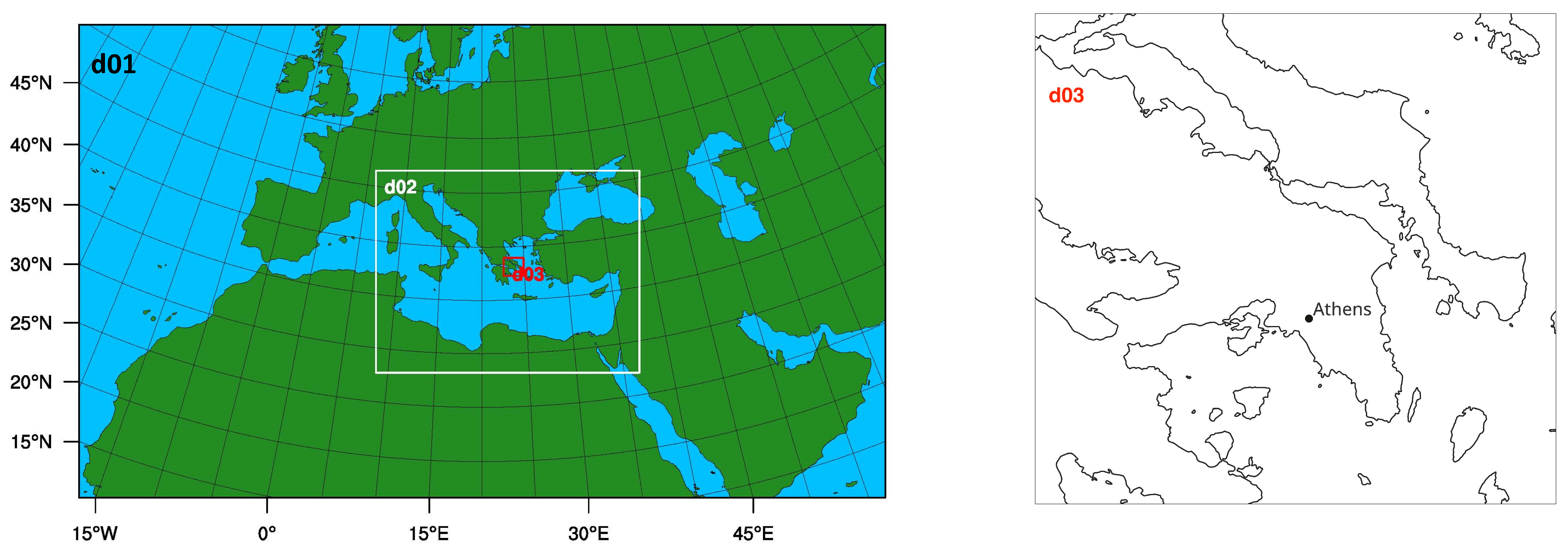

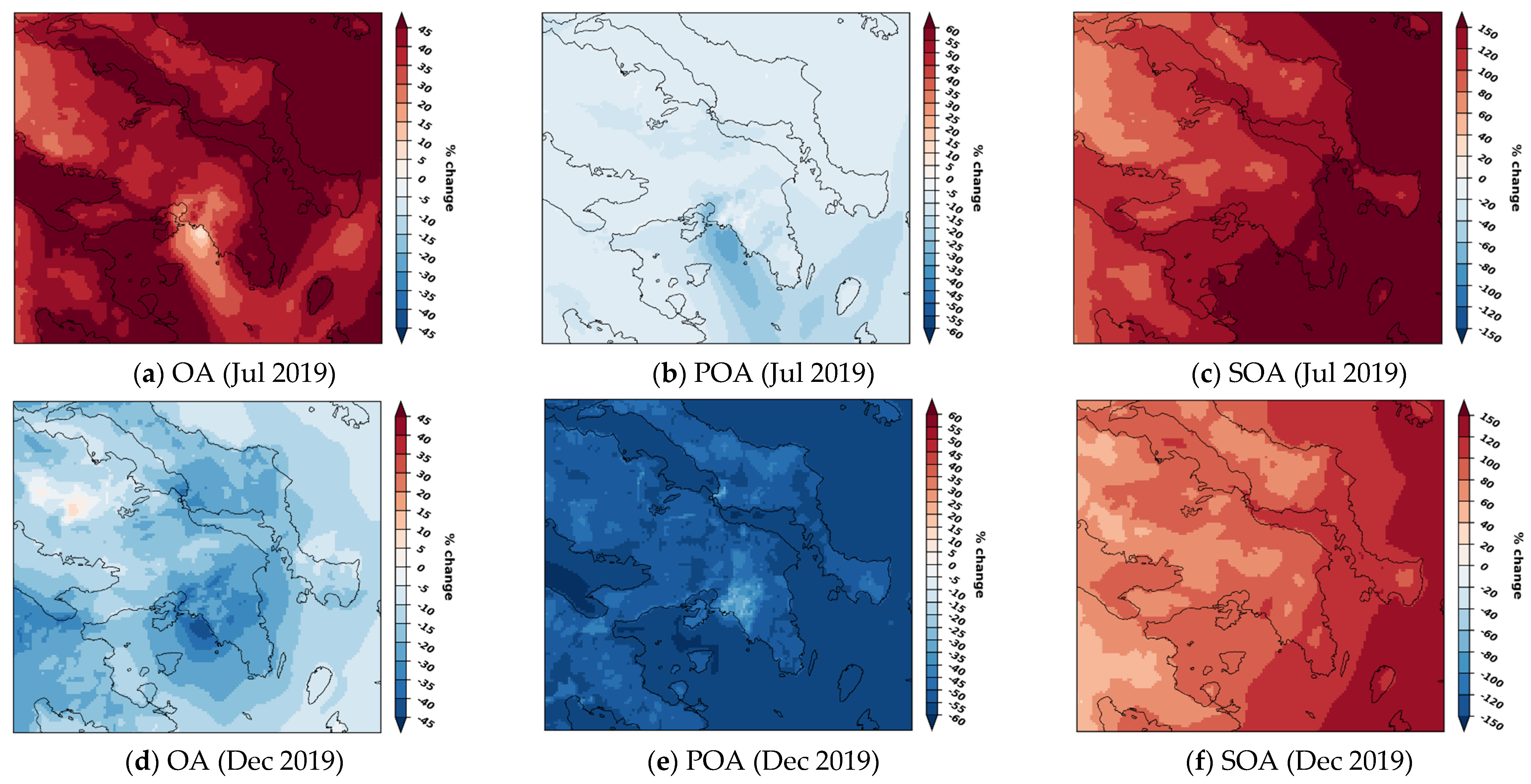
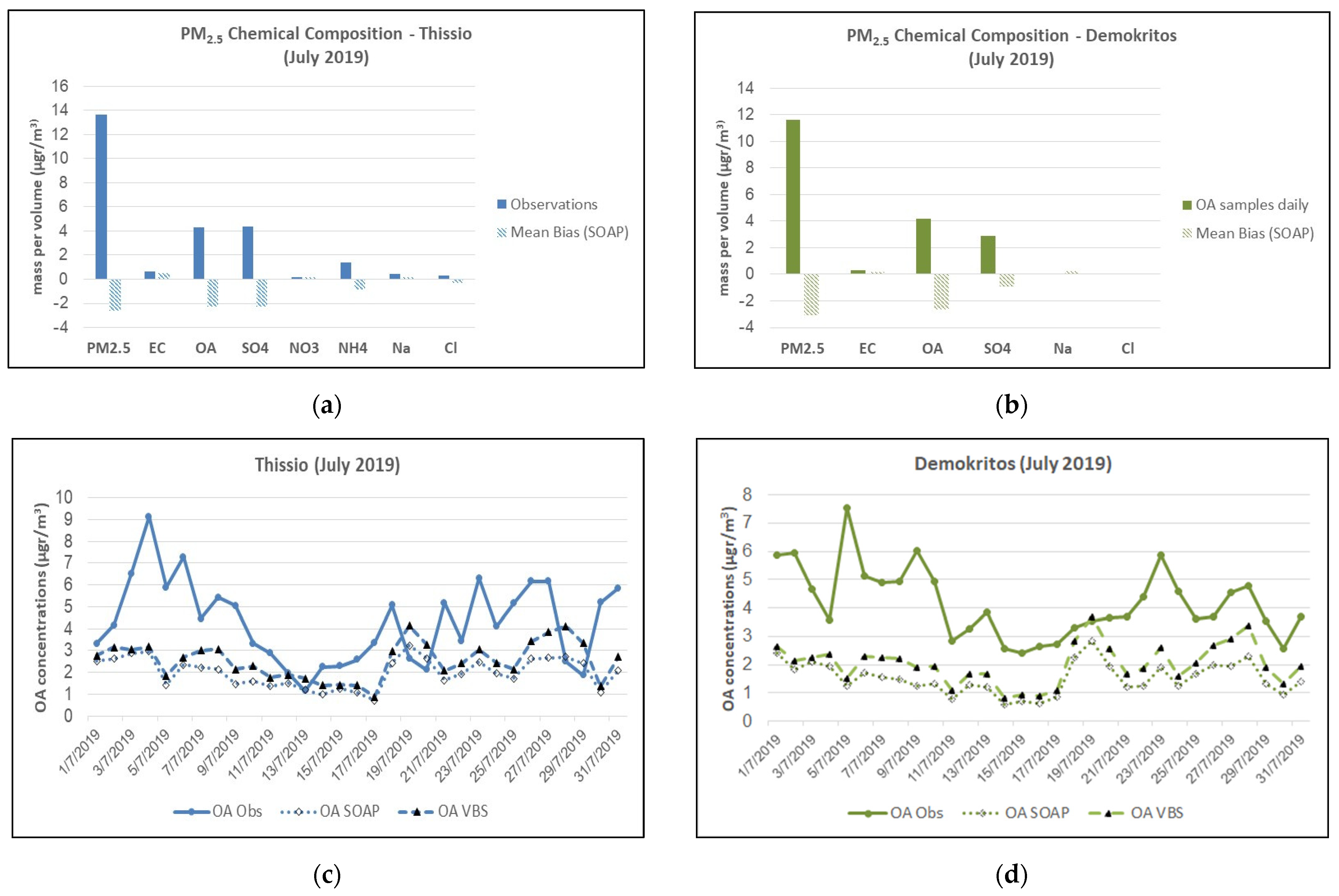
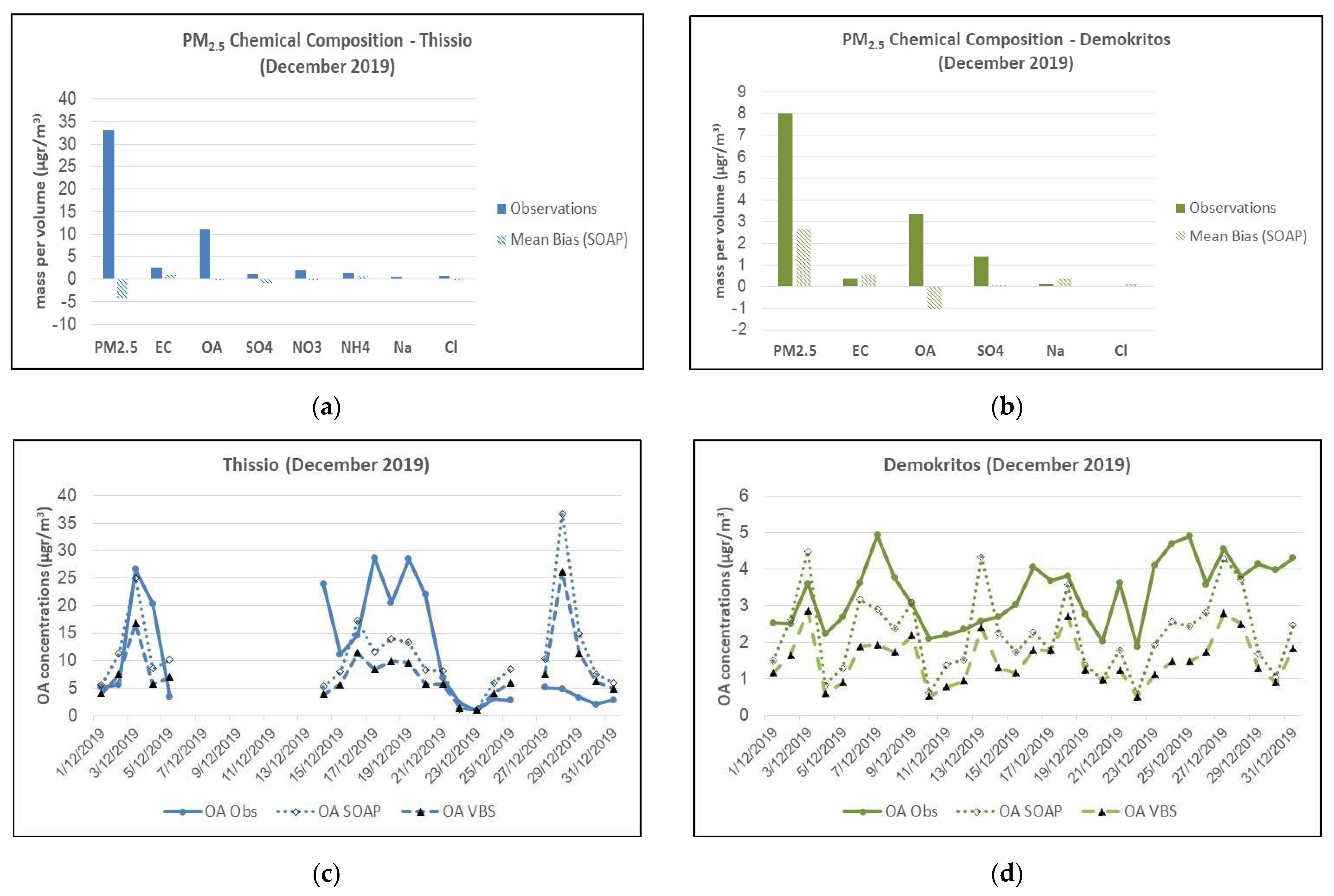
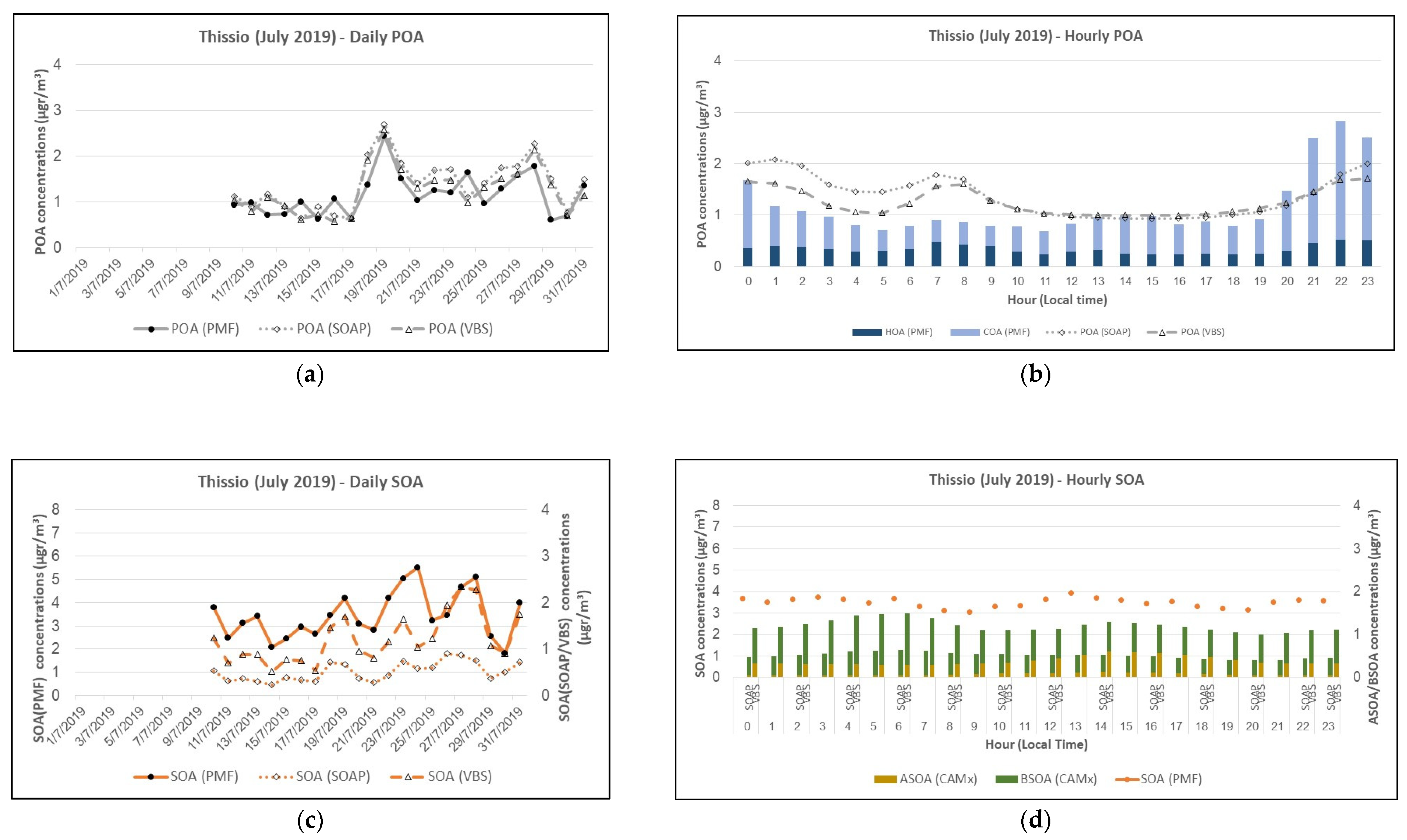

| PM10 * | PM2.5 * | PM2.5 ** | ||||||||||||
|---|---|---|---|---|---|---|---|---|---|---|---|---|---|---|
| UT | UB | SB | UT | SB | UB | SB | ||||||||
| Statistical Indicator (Unit) *** | SOAP | VBS | SOAP | VBS | SOAP | VBS | SOAP | VBS | SOAP | VBS | SOAP | VBS | SOAP | VBS |
| NMB (%) | −12.21 | −10.35 | 3.96 | 6.56 | −13.56 | −10.99 | −21.78 | −18.03 | −36.28 | −32.43 | 7.43 | 12.61 | −14.44 | −9.16 |
| NMSE (-) | 0.33 | 0.32 | 0.54 | 0.52 | 0.80 | 0.77 | 0.21 | 0.18 | 0.45 | 0.39 | 0.25 | 0.24 | 0.34 | 0.30 |
| IOA (-) | 0.60 | 0.60 | 0.53 | 0.52 | 0.47 | 0.47 | 0.62 | 0.63 | 0.49 | 0.51 | 0.48 | 0.48 | 0.48 | 0.49 |
| MFB (-) | −0.27 | −0.24 | −0.12 | −0.09 | −0.37 | −0.33 | −0.30 | −0.25 | −0.52 | −0.46 | −0.01 | 0.04 | −0.24 | −0.18 |
| MFE (-) | 0.42 | 0.40 | 0.35 | 0.33 | 0.55 | 0.52 | 0.40 | 0.36 | 0.59 | 053 | 0.35 | 0.33 | 0.46 | 0.42 |
| PM10 * | PM2.5 * | PM2.5 ** | ||||||||||||
|---|---|---|---|---|---|---|---|---|---|---|---|---|---|---|
| UT | UB | SB | UT | SB | UB | SB | ||||||||
| Statistical Indicator (Unit) *** | SOAP | VBS | SOAP | VBS | SOAP | VBS | SOAP | VBS | SOAP | VBS | SOAP | VBS | SOAP | VBS |
| NMB (%) | +15.90 | +6.06 | +4.08 | −1.84 | +12.09 | +8.67 | +23.88 | +10.88 | +9.86 | +4.12 | +23.50 | +10.59 | −14.50 | −20.58 |
| NMSE (-) | 0.14 | 0.12 | 0.14 | 0.14 | 0.16 | 0.17 | 0.18 | 0.13 | 0.21 | 0.21 | 0.27 | 0.24 | 0.31 | 0.38 |
| IOA (-) | 0.88 | 0.89 | 0.90 | 0.90 | 0.93 | 0.93 | 0.86 | 0.89 | 0.85 | 0.86 | 0.79 | 0.81 | 0.68 | 0.65 |
| MFB (-) | +0.16 | +0.08 | +0.05 | −0.01 | +0.02 | −0.02 | +0.24 | +0.14 | +0.02 | −0.04 | +0.22 | +0.13 | −0.19 | −0.27 |
| MFE (-) | 0.34 | 0.32 | 0.34 | 0.33 | 0.33 | 0.33 | 0.39 | 0.36 | 0.32 | 0.33 | 0.42 | 0.40 | 0.37 | 0.42 |
| Thissio | Demokritos | |||||||
|---|---|---|---|---|---|---|---|---|
| July 2019 | December 2019 | July 2019 | December 2019 | |||||
| Statistical Indicator (Unit) * | SOAP | VBS | SOAP | VBS | SOAP | VBS | SOAP | VBS |
| NMB (%) | −19.23 (−53.18) | −15.07 (−40.30) | −13.15 (−2.27) | −23.78 (−30.35) | −26.67 (−63.43) | −22.37 (−51.28) | +33.40 (−31.62) | +23.73 (−54.07) |
| NMSE (-) | 0.40 (0.93) | 0.36 (0.52) | 0.17 (0.98) | 0.23 (1.30) | 0.36 (1.30) | 0.31 (0.70) | 0.16 (0.29) | 0.11 (0.76) |
| IOA (-) | 0.49 (0.52) | 0.50 (0.56) | 0.81 (0.52) | 0.76 (0.50) | 0.56 (0.42) | 0.57 (0.47) | 0.86 (0.58) | 0.90 (0.48) |
| MFB (-) | −0.18 (−0.66) | −0.13 (−0.44) | −0.12 (−0.15) | −0.24 (−0.10) | −0.38 (−0.93) | −0.32 (−0.69) | +0.29 (−0.45) | +0.21 (−0.77) |
| MFE (-) | 0.45 (0.66) | 0.43 (0.49) | 0.41 (0.69) | 0.44 (0.69) | 0.51 (0.93) | 0.45 (0.69) | 0.31 (0.51) | 0.26 (0.77) |
Disclaimer/Publisher’s Note: The statements, opinions and data contained in all publications are solely those of the individual author(s) and contributor(s) and not of MDPI and/or the editor(s). MDPI and/or the editor(s) disclaim responsibility for any injury to people or property resulting from any ideas, methods, instructions or products referred to in the content. |
© 2025 by the authors. Licensee MDPI, Basel, Switzerland. This article is an open access article distributed under the terms and conditions of the Creative Commons Attribution (CC BY) license (https://creativecommons.org/licenses/by/4.0/).
Share and Cite
Poupkou, A.; Kontos, S.; Liora, N.; Tsiaousidis, D.; Kapsomenakis, I.; Solomos, S.; Liakakou, E.; Athanasopoulou, E.; Grivas, G.; Bougiatioti, A.; et al. Investigating the Role of Organic Aerosol Schemes in the Simulation of Atmospheric Particulate Matter in a Large Mediterranean Urban Agglomeration. Sustainability 2025, 17, 2619. https://doi.org/10.3390/su17062619
Poupkou A, Kontos S, Liora N, Tsiaousidis D, Kapsomenakis I, Solomos S, Liakakou E, Athanasopoulou E, Grivas G, Bougiatioti A, et al. Investigating the Role of Organic Aerosol Schemes in the Simulation of Atmospheric Particulate Matter in a Large Mediterranean Urban Agglomeration. Sustainability. 2025; 17(6):2619. https://doi.org/10.3390/su17062619
Chicago/Turabian StylePoupkou, Anastasia, Serafim Kontos, Natalia Liora, Dimitrios Tsiaousidis, Ioannis Kapsomenakis, Stavros Solomos, Eleni Liakakou, Eleni Athanasopoulou, Georgios Grivas, Aikaterini Bougiatioti, and et al. 2025. "Investigating the Role of Organic Aerosol Schemes in the Simulation of Atmospheric Particulate Matter in a Large Mediterranean Urban Agglomeration" Sustainability 17, no. 6: 2619. https://doi.org/10.3390/su17062619
APA StylePoupkou, A., Kontos, S., Liora, N., Tsiaousidis, D., Kapsomenakis, I., Solomos, S., Liakakou, E., Athanasopoulou, E., Grivas, G., Bougiatioti, A., Petrinoli, K., Diapouli, E., Vasilatou, V., Papagiannis, S., Progiou, A., Kalabokas, P., Melas, D., Mihalopoulos, N., Gerasopoulos, E., ... Zerefos, C. (2025). Investigating the Role of Organic Aerosol Schemes in the Simulation of Atmospheric Particulate Matter in a Large Mediterranean Urban Agglomeration. Sustainability, 17(6), 2619. https://doi.org/10.3390/su17062619
















